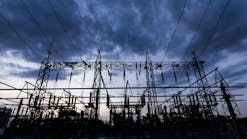Total Gas Pressure: A New Approach to Transformer Air Leak Detection
With new technologies coming online and old assets still in use, there are many different and interesting opportunities to improve how the power industry operates. This underscores the importance of power transformer monitoring.
One of the most important elements of the electric power system, power transformers enable the interconnection of different voltage levels to transfer energy over long distances. Among the most expensive components in the network, transformers must be monitored to detect any problems as early as possible to avoid sudden failures and electricity outages.
Detecting problems at an early stage enables power utilities to schedule a planned service break to make any necessary repairs or carry out maintenance, thereby avoiding a failure. Since a power transformer's residual life depends heavily on the condition of the insulation paper within its windings, keeping the transformer free of oxygen is crucial.
Shortcomings of Traditional Monitoring Methods
Over the past few decades, techniques to measure the oxygen and moisture that degrade and age the paper have been developed and refined, but the increased use of sealed transformer designs means the issue of air leaks as a source of oxygen has grown in importance. The presence of oxygen in transformer oil accelerates aging of the transformer insulation, so monitoring and confirming proper sealing against ambient air ingress is crucial to maximizing a transformer’s operational life.
New power transformers tend to be sealed to keep oxygen and atmospheric humidity out, and many old transformers are retrofitted with sealing systems, but confirming that the tanks remain sealed is challenging. While measuring oxygen concentration in oil is one way to confirm oxygen ingress, measuring oxygen directly won’t reveal if oxygen gets in and is consumed in oxidation reactions. Compounding the issue, there is no international standard for interpretation guidance of oxygen concentration in transformer oil.
Air leaks have traditionally been detected by measuring oxygen and nitrogen from standard dissolved gas analysis (DGA) oil samples. However, the challenge with sampling at the transformer site, followed by transportation and handling of the samples, is the risk of sample contamination with ambient air. Even though some monitors have integrated oxygen measurement, and nitrogen levels are calculated based on the oxygen values, those calculations fail to take into account that such calculated nitrogen values are valid for free breathing transformer only — not for sealed transformers.
Because these monitoring techniques have significant shortcomings, Vaisala developed a new method to detect air leaks by measuring total gas pressure — and with great results.
An Easier Way to Detect Ingress of Air
Enter the total gas pressure (TGP) method. A step forward from the traditional measurement methods to detect air leaks, measuring TGP detects the total pressure of all gases dissolved in oil.
By extracting all gases from a drawn oil sample under vacuum, it is easy to measure the pressure of those gases in a controlled environment. A well-sealed transformer will maintain low levels of gas pressure for decades, even up to the full lifetime of the transformer. The pressure value will be far below atmospheric pressure, so if that value starts increasing, that is a clear indication that air is coming in, signaling an issue with sealing, either with materials or even workmanship should the increase appear after maintenance.
In the case of an air leak, the largest portion of gases would be nitrogen and oxygen, both of which can be completely extracted from oil due to their poor solubility. Oxygen sensors cannot detect air leaks if there is an oxygen-consuming reactions in the transformer. However, even if all oxygen has been consumed, the TGP value will still give a reliable indication of a leak because the nitrogen value will both dominate and increase over time since it is neither formed nor consumed in the transformer.
Because TGP measurement gives a direct indication on whether a transformer is sealed, TGP at atmospheric pressure level is an indication that the transformer is either free-breathing or a sealed transformer with a severe air leak. TGP is a very simple and intuitive parameter, the pressure measurement will show decision-makers at a glance if there’s an air leak — no specialist opinion nor interpretation is needed. If TGP indicates a sealing issue, that problem can be addressed during the transformer’s next service break to minimize further degradation of the insulating paper.
In short, the TGP method helps power utilities to detect and repair any air ingress early, ultimately extending the lifetime of a transformer and leading to major cost savings.


